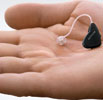

Danish company GN ReSound has developed an innovative hearing aid product – the ReSound Alera – that enables users to wirelessly stream audio from common consumer electronics (CE) devices such as TVs and smartphones (the latter via a chest-worn Bluetooth wireless technology microphone clip) directly to their hearing aids over a range of up to 20 metres.
In operation, the end user simply connects their TV (eg, via a SCART cable) or other CE device (eg, desktop PCs, laptops, tablet computers, home cinema systems, radios) to a small audio streamer box equipped with an nRF24L01 2,4 GHz transceiver from Nordic Semiconductor. This then pairs with a second nRF24L01 located in the ReSound Alera hearing aid.
When the user wishes to watch TV they simply push a button on the back of their hearing aid or use a remote control to select the device’s designated wireless channel to immediately stream wireless audio in stereo direct from the TV to their hearing aid.
“It was extremely challenging to achieve this ease of end-user functionality, along with medical-grade field reliability (99,99%) and real-time audio performance in a hearing aid as small as an adult fingernail and weighing as much as a paper clip,” admits Thomas Olsgaard, VP of Hardware Platforms at GN ReSound.
The entire ReSound Alera product range is built around a uniquely miniature 2 cm (length) x 1,5 cm (height) x 0,6 cm (thick) product form factor that has to embed an even smaller 1,4 cm (length) x 0,6 cm (height) x 0,4 cm (thick) electronic module housing an antenna without groundplane (due to lack of space), Bluetooth wireless technology radio, a proprietary (Nordic nRF24L01) 2,4 GHz radio, plus an external microcontroller to perform the advanced audio signal processing (background noise cancellation and ‘surround’ sound processing) required in a hearing aid product marketed as being so sensitive it allows hearing-impaired users to hear, for example, snow being crushed under their footsteps, birds singing, and even the sound of falling rain.
Olsgaard continues: “But all of this functionality needed to run for several days from a replaceable ZincAir battery that is a fuel coin cell (that can store around three times more energy than a standard coin cell). This meant that the proprietary radio needed the lowest possible power consumption to enable the product to average 1,5 mA in operation and peak at 4 mA when streaming.
“In addition, the hearing aid needed to offer near 100% medical-grade operational reliability. For us this meant being able to work reliably and offer real-time audio streaming equating to 20 ms maximum latency from the source CE device to the reception in the ear – even in the most hostile 2,4 GHz operating environments such as 10 active 2,4 GHz emitters all operating in the vicinity (eg, smartphones, computer tablets, gaming devices and Wi-Fi hubs). And this demanded an extremely robust protocol design and an ultra linear radio performance from the Nordic chip that pushed this chip’s operational capabilities to the limit – down to the system architectural level – in a way we are not sure any other manufacturer’s 2,4 GHz chip could actually manage.”
For more information contact Andrew Hutton, RF Design, +27 (0)21 555 8400, sales@rfdesign.co.za, www.rfdesign.co.za
| Tel: | +27 21 555 8400 |
| Email: | sales@rfdesign.co.za |
| www: | www.rfdesign.co.za |
| Articles: | More information and articles about RF Design |

© Technews Publishing (Pty) Ltd | All Rights Reserved